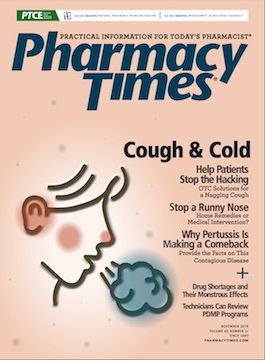Publication
Article
Pharmacy Times
A Pharmacist's Guide to a Once-Daily Treatment for Chronic Hepatitis B Infection
http://www.gilead.com/~/media/files/pdfs/medicines/liver-disease/vemlidy/vemlidy_pi.pdf?la=en
This article is sponsored by Gilead Sciences, Inc.
Chronic hepatitis B (CHB) can be a serious, potentially lifelong disease, and many patients may require long-term treatment to reduce the risk of disease progression.1,2 Patients with CHB may be at risk for developing severe liver complications, including cirrhosis and liver cancer.2 In addition, patients with CHB are aging and associated to have more comorbidities, such as renal and bone disease, than patients without CHB.3,4 These factors are important considerations when managing patients with CHB.3
Antiviral therapies are available for the treatment of CHB and have been shown to reduce the progression to advanced liver disease such as hepatocellular carcinoma and cirrhosis.5,6 Currently, the preferred first-line oral antiviral therapies for CHB as recommended by the American Association for the Study of Liver Diseases (AASLD) include tenofovir disoproxil fumarate (TDF), entecavir, and more recently, tenofovir alafenamide (TAF; VEMLIDY®).1 VEMLIDY was approved by the FDA in 2016 for the treatment of CHB in adults with compensated liver disease.7,8
In addition to the AASLD, guidelines from the European Association for the Study of the Liver (EASL) in 2017, and the Asian American Treatment Algorithm (AATA) in 2018, recommended VEMLIDY as one of the preferred first-line therapies to treat CHB.1,5,6
VEMLIDY is a novel, targeted prodrug of tenofovir that is efficiently delivered to the hepatocyte, the active site. VEMLIDY has a longer plasma half-life and greater plasma stability than TDF (another prodrug of tenofovir). VEMLIDY is approximately one-tenth the dose of TDF with 89% less systemic exposure to tenofovir.7,9-12
IMPORTANT SAFETY INFORMATIONBOXED WARNING: POST TREATMENT SEVERE ACUTE EXACERBATION OF HEPATITIS B
- Discontinuation of anti-hepatitis B therapy, including VEMLIDY, may result in severe acute exacerbations of hepatitis B. Hepatic function should be monitored closely with both clinical and laboratory follow-up for at least several months in patients who discontinue anti-hepatitis B therapy, including VEMLIDY. If appropriate, resumption of anti-hepatitis B therapy may be warranted.
Please see additional Important Safety Information for VEMLIDY throughout this article.
Please click here for full Prescribing Information for VEMLIDY, including BOXED WARNING.
CLINICAL TRIALS
The efficacy and safety of VEMLIDY in the treatment of adults with CHB with compensated liver disease were established based on data from 2 randomized, double-blind, active-controlled, noninferiority studies, 108 and 110. Patients were randomized 2:1 to receive VEMLIDY 25 mg or TDF 300 mg. Study 108 included 425 patients who were hepatitis B envelope antigen negative (HBeAg−); Study 110 included 873 patients who were HBeAg positive (HBeAg+). The mean age of patients across both studies was 40 years (range, 18-80) for those who received VEMLIDY and 41 years (range, 18-72) for those who received TDF. The mean hepatitis B virus (HBV) DNA was 7.0 log10 IU/mL (SD = 1.6) for patients in the pooled study populations, regardless of treatment.7,10,13 Additional baseline characteristics are listed in TABLE 1.14,15
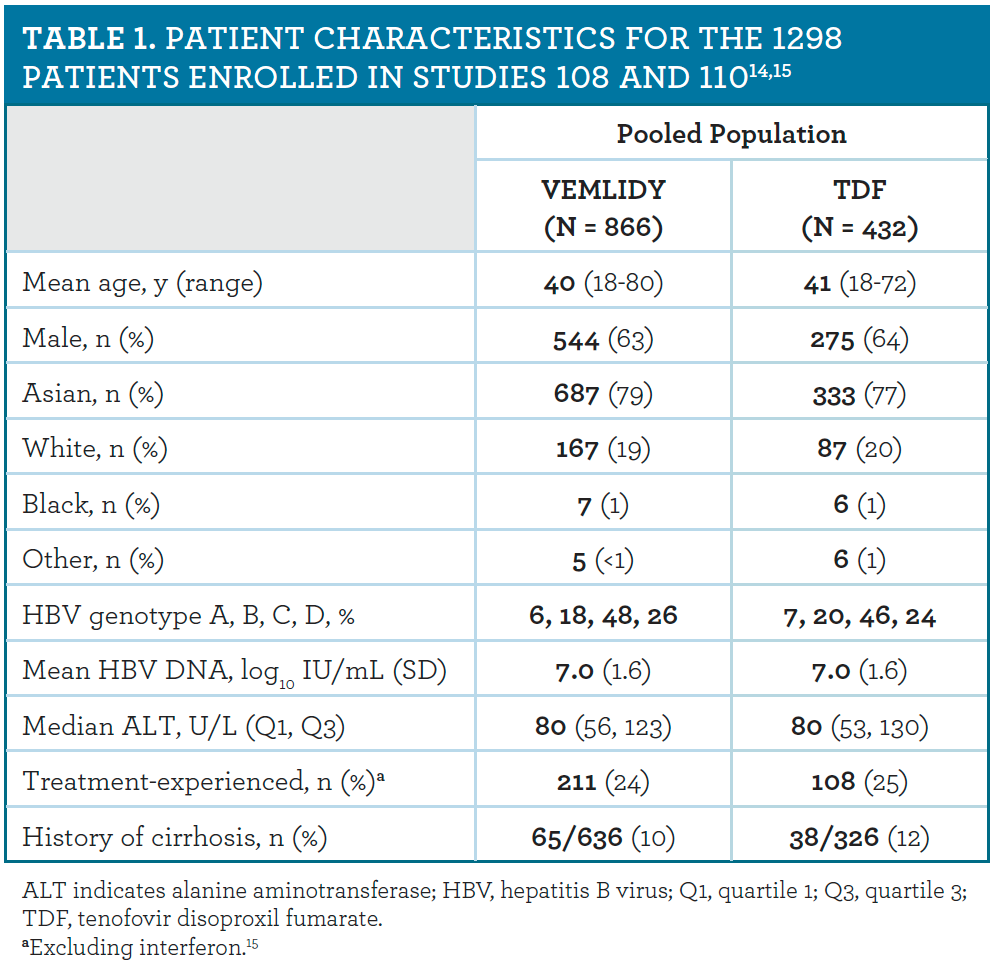
The original study design consisted of a 96-week, double-blind phase followed by an open-label phase to Week 144. The study design was later amended to extend the double-blind phase from 96 to 144 weeks and the open-label phase to Week 384. Before the amendment to the double-blind phase was implemented, 540 patients had already entered the open-label phase at Week 96; 360 patients remained on VEMLIDY and 180 patients switched from TDF to VEMLIDY at Week 96.7,10,13,14 Baseline characteristics for patients in the Weeks 96 through 144 open-label phase are listed in
TABLE 2
.15
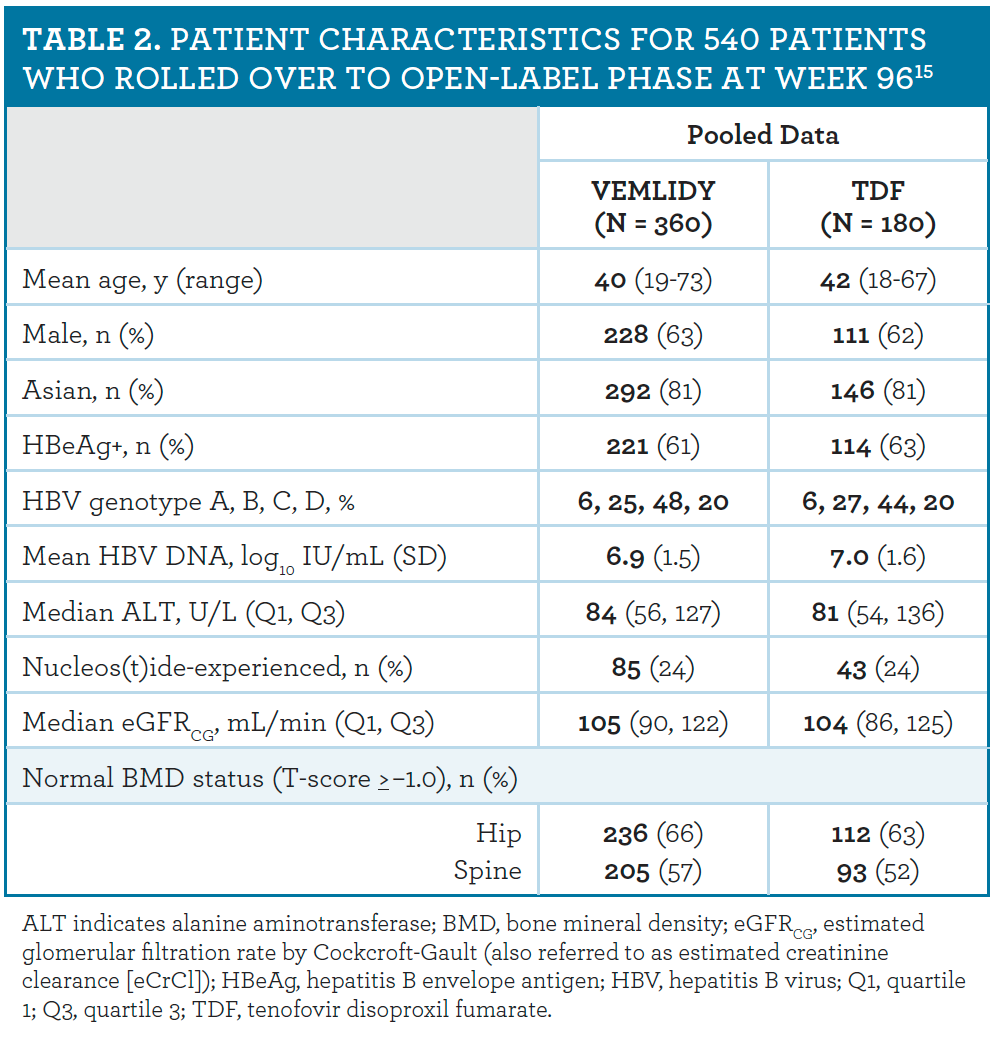
The primary endpoint for Studies 108 and 110 was the proportion of patients with plasma HBV DNA levels less than 29 IU/mL, and noninferiority to TDF (10% margin; 95% CI approach) at Week 48; this was also one of the key secondary endpoints at Weeks 96 and 144. Patients were included if they had an index HBV DNA of 20,000 IU/mL or higher; an alanine aminotransferase (ALT) concentration greater than 60 U/L (males) or greater than 38 U/L (females), and at most, 10 times the upper limit of normal by central laboratory range; and estimated creatinine clearance (eCrCl) of at least 50 mL/min.7,10,13
IMPORTANT SAFETY INFORMATION (continued)
Warnings and Precautions
- Risk of Development of HIV-1 Resistance in HBV/HIV-1 Coinfected Patients: Due to this risk, VEMLIDY alone should not be used for the treatment of HIV-1 infection. Safety and efficacy of VEMLIDY have not been established in HBV/HIV-1 coinfected patients. HIV antibody testing should be offered to all HBV-infected patients before initiating therapy with VEMLIDY, and, if positive, an appropriate antiretroviral combination regimen that is recommended for HBV/HIV-1 coinfected patients should be used.
- New Onset or Worsening Renal Impairment: Cases of acute renal failure and Fanconi syndrome have been reported with the use of tenofovir prodrugs. In clinical trials of VEMLIDY, there have been no cases of Fanconi syndrome or proximal renal tubulopathy (PRT). Patients with impaired renal function and/or taking nephrotoxic agents (including NSAIDs) are at increased risk of renal-related adverse reactions. Discontinue VEMLIDY in patients who develop clinically significant decreases in renal function or evidence of Fanconi syndrome. Monitor renal function in all patients — See Dosage and Administration.
- Lactic Acidosis and Severe Hepatomegaly with Steatosis: Fatal cases have been reported with the use of nucleoside analogs, including tenofovir DF. Discontinue VEMLIDY if clinical or laboratory findings suggestive of lactic acidosis or pronounced hepatotoxicity develop, including hepatomegaly and steatosis in the absence of marked transaminase elevations.
Please see additional Important Safety Information for VEMLIDY throughout this article.
Please click here for full Prescribing Information for VEMLIDY, including BOXED WARNING.
Efficacy
In both treatment-naïve and treatment-experienced patients with CHB and compensated liver disease, including many patients with cirrhosis and those who received prior entecavir or TDF, VEMLIDY demonstrated high rates of viral suppression and improved rates of ALT normalization compared with TDF through 3 years (TABLES 3 and 4).7,10,13-17 Among 1298 patients enrolled across both studies, no cases of resistance to VEMLIDY were reported.1,7,14-18
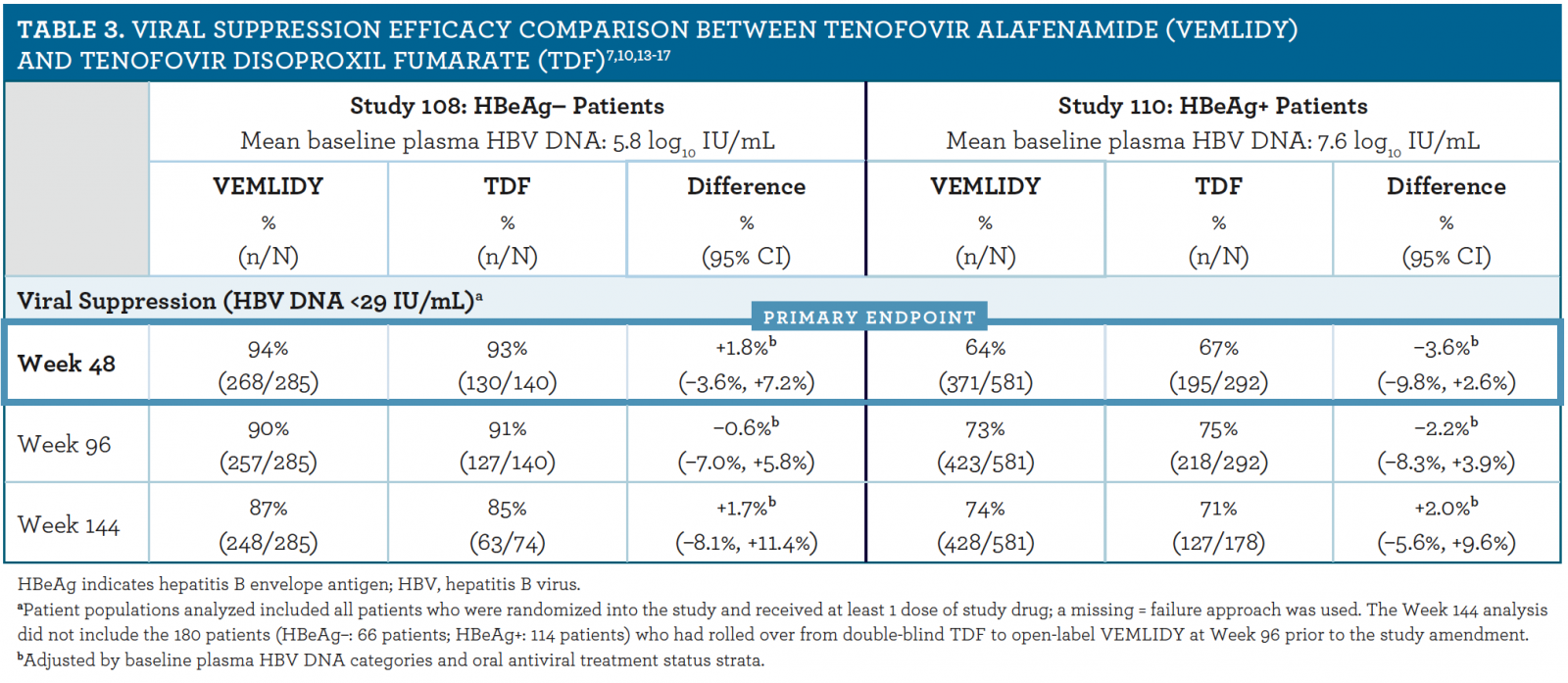
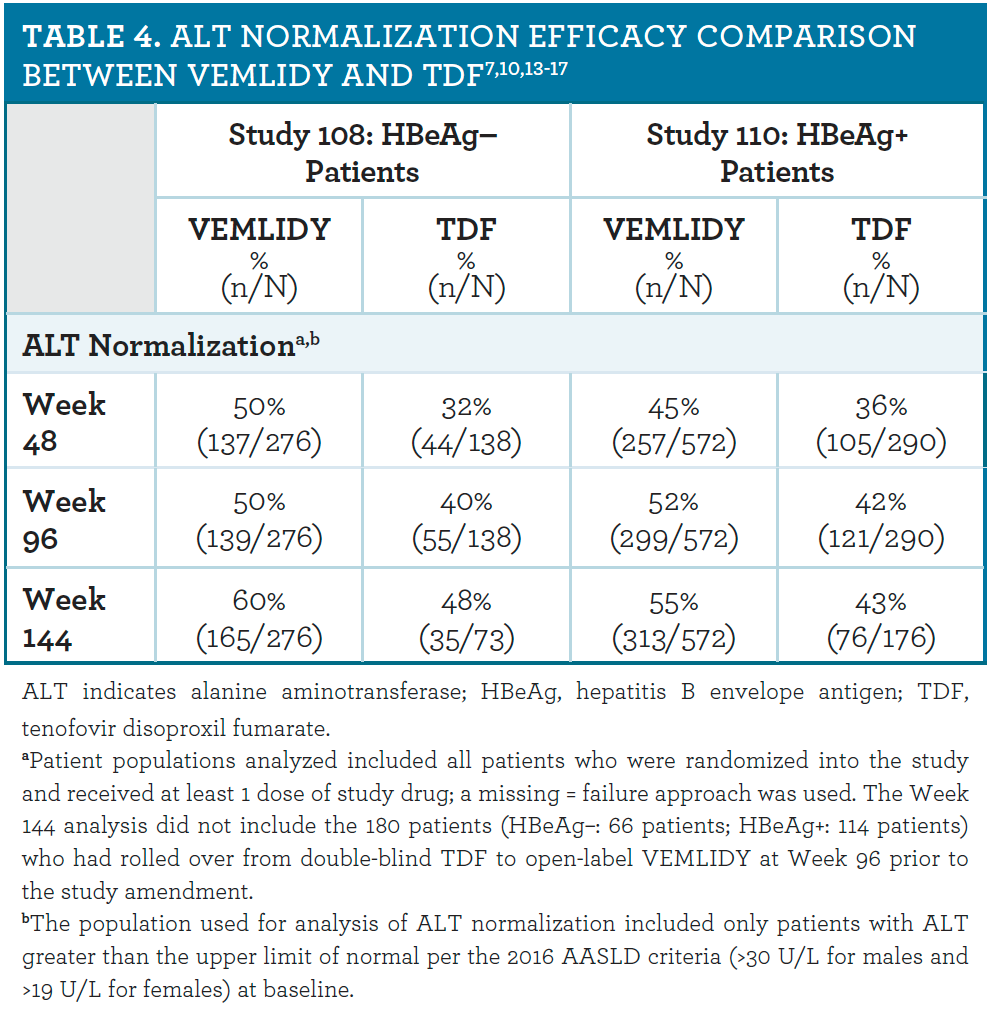
Safety
The US prescribing information for VEMLIDY (tenofovir alafenamide) contains a boxed warning on post treatment severe acute exacerbation of hepatitis B. Due to the risk of development of HIV-1 resistance, VEMLIDY alone is not recommended for the treatment of HIV-1 infection. Renal impairment, including cases of acute renal failure and Fanconi syndrome, has been reported with the use of tenofovir prodrugs in both animal toxicology studies and human trials. Lactic acidosis and severe hepatomegaly with steatosis, including fatal cases, have been reported with the use of nucleoside analogues, including TDF—another prodrug of tenofovir—alone or in combination with other antiretrovirals.7
VEMLIDY and TDF have shown similar rates of adverse events (AEs). The most common AEs (all grades) reported in at least 5% of patients in the VEMLIDY group are listed in TABLE 5.7,15
RENAL AND BONE SAFETY
The effects of VEMLIDY and TDF on renal laboratory parameters and bone mineral density (BMD) were compared in a pooled analysis of data from Studies 108 and 110. VEMLIDY showed reduced effect on renal safety parameters and less impact on BMD compared with TDF (FIGURES 2 and 3).7,10,13-16,19,20
At Week 96, 11% of patients in the VEMLIDY group and 25% of patients in the TDF group had a BMD decline at the lumbar spine of 5% or greater; the corresponding percentages at Week 144 were 12% (VEMLIDY) and 24% (TDF). In addition, at Week 96, 5% of patients in the VEMLIDY group and 13% of patients in the TDF group had a BMD decline at the femoral neck of 7% or greater; the corresponding percentages at Week 144 were 9% (VEMLIDY) and 16% (TDF).7,14-16
At year 3, patients who received VEMLIDY had less decline in estimated glomerular filtration rate by the Cockcroft-Gault method (eGFRCG), and patients receiving VEMLIDY had less decline in BMD at the hip and spine compared with patients who received TDF.7,10,13-16,19,20
It is important to note that the long-term clinical significance of these renal laboratory changes on adverse reaction frequencies between VEMLIDY and TDF, and of these BMD changes, is not known. Studies evaluating outcomes through year 8 are ongoing.7
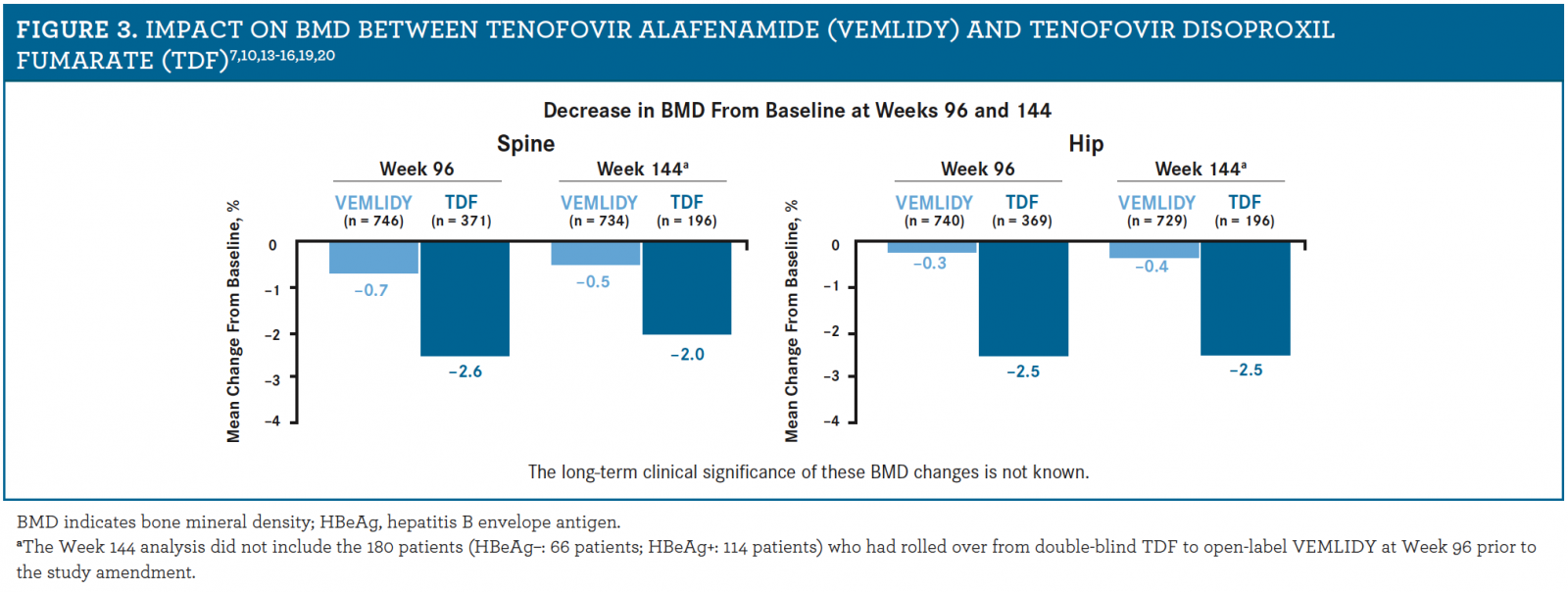
Differences in certain lipid parameters were observed in patients treated with VEMLIDY compared with TDF in both studies at Week 96 and Week 144. These differences included mean changes in fasting low-density lipoprotein (LDL) cholesterol and triglycerides of +7 mg/dL and +13 mg/dL, respectively, for VEMLIDY versus −10 mg/dL and −7 mg/dL for TDF from baseline to Week 96. Mean changes for LDL and triglycerides of +8 mg/dL and +18 mg/dL, respectively, for VEMLIDY and −8 mg/dL and −2 mg/dL, respectively, for TDF were observed at Week 144. A total of 6% of patients who received VEMLIDY and 1% of patients who received TDF had a fasting LDL cholesterol greater than 190 mg/dL at Week 96; 7% of patients who received VEMLIDY and 1% of patients who received TDF had a fasting LDL cholesterol greater than 190 mg/dL at Week 144. The mean change in the total cholesterol to high-density lipoprotein cholesterol ratio at Week 96 and Week 144 from baseline was 0 for both VEMLIDY and TDF.7,15
RENAL AND BONE SAFETY IN PATIENTS WHO SWITCHED FROM TDF TO VEMLIDY AT WEEK 96
A pooled analysis was conducted of patients on open-label treatment from Week 96 through Week 144 (48-week safety data). Patients who switched from TDF to VEMLIDY at Week 96 showed an improvement in eGFRCG at Week 144. The median change in eGFRCG from Week 96 to Week 120 was −0.6 mL/min in subjects who remained on VEMLIDY and +1.8 mL/min in subjects who switched from TDF to VEMLIDY.7 The median change in eGFRCG from baseline to Week 144 was −1.0 mL/min, versus −4.8 mL/min seen at Week 96 prior to the switch to VEMLIDY (
FIGURE 4
).7,15
The long-term clinical significance of these renal laboratory changes on adverse reaction frequencies between VEMLIDY and TDF is not known.7
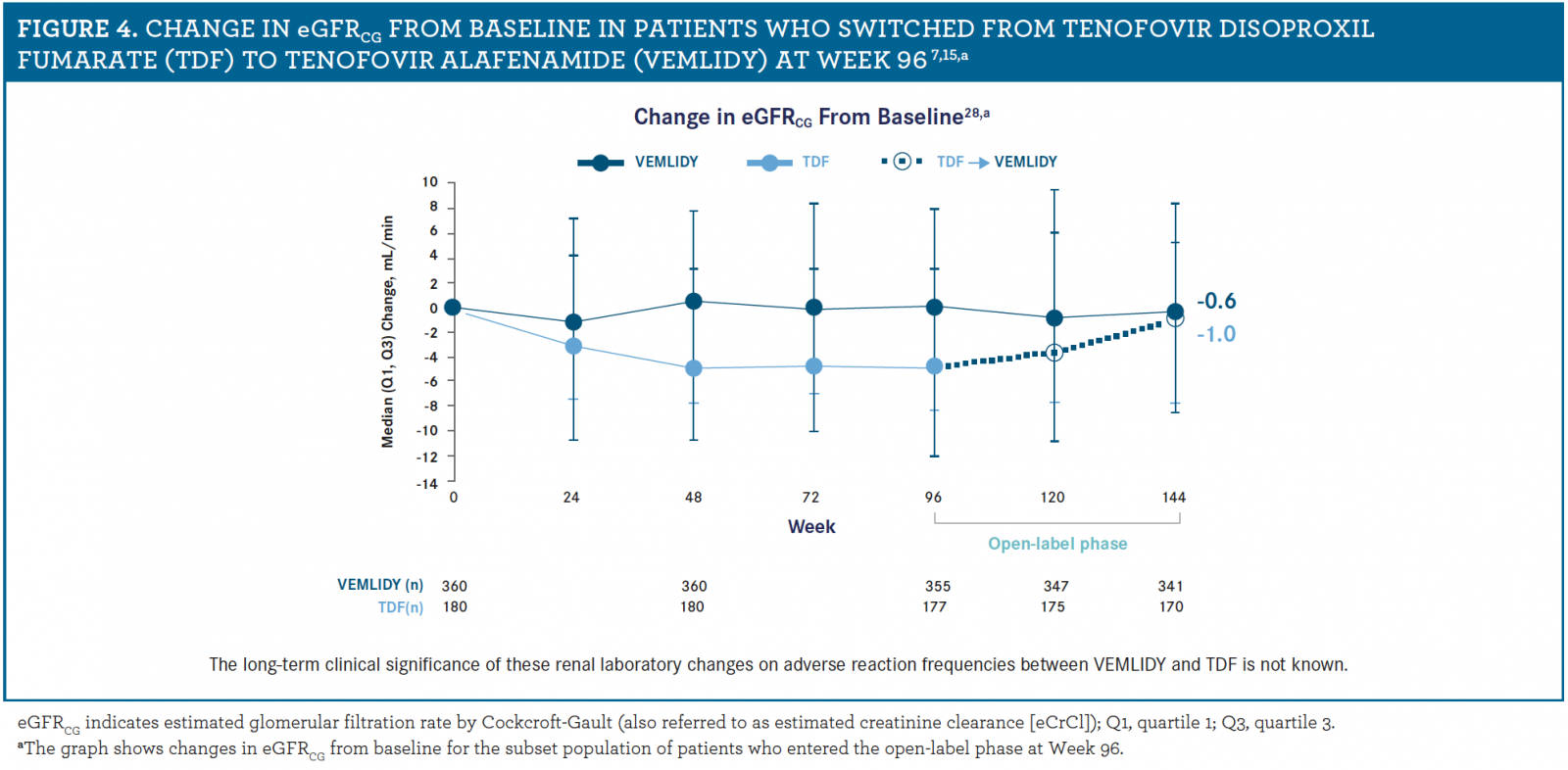
Similarly, patients who switched from TDF to VEMLIDY at Week 96 experienced an improvement in spine and hip BMD at Week 144. The mean percentage change in lumbar spine and total hip BMD, respectively, from Week 96 to Week 120 was +0.6% and 0% in patients who remained on VEMLIDY, and +1.7% and +0.6% in those who switched from TDF to VEMLIDY. At Week 144, the mean changes in lumbar spine and total hip BMD from baseline were −1.3% and −1.7%, respectively, and about −3% mean change from baseline at Week 96, prior to switching. Patients who remained on VEMLIDY had a mean BMD change of −0.5% from baseline at Week 144 at both the lumbar spine and total hip. The long-term clinical significance of these BMD changes is not known.7,15
The safety profile of VEMLIDY in patients who remained on VEMLIDY in the open-label phase through Week 144 was similar to that of patients who switched from TDF to VEMLIDY at Week 96. Overall, VEMLIDY maintained similar viral suppression as TDF with less impact on renal and bone safety parameters.7,10,13-16,19,20
IMPORTANT SAFETY INFORMATION (continued)
Adverse Reactions
Most common adverse reactions (incidence ≥5%; all grades) were headache, abdominal pain, cough, back pain, fatigue, nausea, arthralgia, diarrhea, and dyspepsia.
Drug Interactions
- Coadministration of VEMLIDY with drugs that reduce renal function or compete for active tubular secretion may increase concentrations of tenofovir and the risk of adverse reactions.
- Coadministration of VEMLIDY is not recommended with the following: oxcarbazepine, phenobarbital, phenytoin, rifabutin, rifampin, rifapentine, or St. John’s wort. Such coadministration is expected to decrease the concentration of tenofovir alafenamide, reducing the therapeutic effect of VEMLIDY. Drugs that strongly affect P-glycoprotein (P-gp) and breast cancer resistance protein (BCRP) activity may lead to changes in VEMLIDY absorption.
Consult the full prescribing information for VEMLIDY for more information on potentially significant drug interactions, including clinical comments.
Please see additional Important Safety Information for VEMLIDY throughout this article.
Please click here for full Prescribing Information for VEMLIDY, including BOXED WARNING.
ROLE OF THE PHARMACIST
As leading medication experts, pharmacists often are asked to provide recommendations on therapy based on patient-related and medication-related variables, to advise on dosing adjustments, to review drug-drug interactions, to monitor patient lab results, and to counsel on the safe utilization of medications. Pharmacists should know that VEMLIDY is indicated for the treatment of CHB in adults with compensated liver disease. Based on clinical data, VEMLIDY has reduced effect on renal safety parameters and less impact on BMD compared with TDF, as well as improved ALT normalization, while maintaining similar viral suppression and with no detectable resistance through week 144.7,9-16,19,20
The recommended dose of VEMLIDY in adults with CHB with compensated liver disease is 25 mg (one tablet) taken orally once daily with food. VEMLIDY is the only oral anti-hepatitis B agent that does not require dose adjustment in patients with mild, moderate, or severe renal impairment, or those with end-stage renal disease (ESRD; eCrCl <15 mL/min) who are on chronic hemodialysis. In patients on chronic hemodialysis, on days of hemodialysis, administer VEMLIDY after the completion of hemodialysis treatment. VEMLIDY is not recommended in patients with ESRD who are not receiving chronic hemodialysis or in patients with decompensated hepatic impairment (Child-Pugh Class B or C).7
HIV antibody testing should be offered to all HBV-infected patients before initiating therapy with VEMLIDY, and if positive, an appropriate antiretroviral combination therapy should be used. Patients should tell their healthcare provider about the use of all medications, as VEMLIDY may interact with other drugs. Because VEMLIDY is a substrate of P-glycoprotein (P-gp) and the breast cancer resistance protein (BCRP), drugs that affect the activity of these proteins may alter the absorption and plasma concentrations of tenofovir alafenamide. Furthermore, because tenofovir is primarily excreted by the kidneys, caution should be used when coadministering VEMLIDY with other renally eliminated drugs as this may increase the risk of AEs and increase concentrations of tenofovir.7
Inform patients that discontinuation of anti-hepatitis B therapy, including VEMLIDY, may result in severe acute exacerbations of hepatitis B. Prior to or when initiating VEMLIDY, and during treatment on a clinically appropriate schedule, assess serum creatinine, eCrCl, urine glucose, and urine protein in all patients. Also assess serum phosphorus in patients with chronic kidney disease. Treatment should be discontinued in patients who develop symptoms or laboratory findings suggestive of lactic acidosis or pronounced hepatotoxicity.7
CO-PAY AND PATIENT SUPPORT PROGRAMS
VEMLIDY® (tenofovir alafenamide) patient support programs assist with out-of-pocket costs and patient access to medication. The VEMLIDY Co-Pay Coupon Program (www.vemlidyhcp.com/copay_patient_support/) and the Gilead Advancing Access Program (www.gileadadvancingaccess.com) can be accessed online.
IMPORTANT SAFETY INFORMATION (continued)
Dosage and Administration
- Testing Prior to Initiation: HIV infection.
- Prior to or when initiating, and during treatment: On a clinically appropriate schedule, assess serum creatinine, estimated creatinine clearance, urine glucose, and urine protein in all patients. In patients with chronic kidney disease, also assess serum phosphorus.
- Dosage in Adults: 1 tablet taken once daily with food.
- Renal Impairment: Not recommended in patients with end stage renal disease (ESRD; eCrCl <15 mL/min) who are not receiving chronic hemodialysis; in patients on chronic hemodialysis, on hemodialysis days, administer VEMLIDY after completion of hemodialysis treatment.
- Hepatic Impairment: Not recommended in patients with decompensated (Child-Pugh B or C) hepatic impairment.
Indication
VEMLIDY is indicated for the treatment of chronic hepatitis B virus (HBV) infection in adults with compensated liver disease.
Please see additional Important Safety Information for VEMLIDY throughout this article.
Please click here for full Prescribing Information for VEMLIDY, including BOXED WARNING.
REFERENCES
1. Terrault NA, Lok ASF, McMahon BJ, et al. Update on prevention, diagnosis, and treatment of chronic hepatitis B: AASLD 2018 hepatitis B guidance. Hepatology. 2018;67(4):1560-1599. doi: 10.1002/hep.29800.
2. World Health Organization. Guidelines for the prevention, care and treatment of persons with chronic hepatitis B infection. Geneva, Switzerland: World Health Organization; 2015. who.int/hiv/pub/hepatitis/hepatitis-b-guidelines/en/. Accessed July 1, 2019.
3. Nguyen MH, Lim JK, Burak Ozbay A, et al. Advancing age and comorbidity in a US insured population-based cohort of patients with chronic hepatitis B. Hepatology. 2019;69(3):959-973. doi: 10.1002/hep.30246.
4. Liu A, Le A, Zhang J, et al. Increasing co-morbidities in chronic hepatitis B patients: experience in primary care and referral practices during 2000-2015. Clin Transl Gastroenterol. 2018;9(3):141. doi: 10.1038/s41424-018-0007-6.
5. European Association for the Study of the Liver. EASL 2017 Clinical Practice Guidelines on the management of hepatitis B virus infection. J Hepatol. 2017;67(2):370-398. doi:10.1016/j.jhep.2017.03.021.
6. Tong MJ, Pan CQ, Han SB, et al. An expert consensus for the management of chronic hepatitis B in Asian Americans. Aliment Pharmacol Ther. 2018;47(8):1181-1200. doi: 10.1111/apt.14577.
7. Vemlidy [prescribing information]. Foster City, CA: Gilead Sciences, Inc.; 2019. gilead.com/~/media/files/pdfs/medicines/liver-disease/vemlidy/vemlidy_pi.pdf?la=en. Accessed April 15, 2019.
8. US FDA; Center for Drug Evaluation and Research. Vemlidy New Drug Application (NDA) 208464 approval letter. FDA website. www.accessdata.fda.gov/drugsatfda_docs/appletter/2016/208464Orig1s000ltr.pdf. Published November 10, 2016. Accessed April 15, 2019.
9. Lee WA, He GX, Eisenberg E, et al. Selective intracellular activation of a novel prodrug of the human immunodeficiency virus reverse transcriptase inhibitor tenofovir leads to preferential distribution and accumulation in lymphatic tissue. Antimicrob Agents Chemother. 2005;49(5):1898-1906. doi: 10.1128/AAC.49.5.1898-1906.2005.
10. Chan HL, Fung S, Seto WK, et al; GS-US-320-0110 Investigators. Tenofovir alafenamide versus tenofovir disoproxil fumarate for the treatment of HBeAg-positive chronic hepatitis B virus infection: a randomised, double-blind, phase 3, non-inferiority trial [published correction appears in Lancet Gastroenterol Hepatol. 2016;1(3):e2]. Lancet Gastroenterol Hepatol. 2016;1(3):185-195. doi: 10.1016/S2468-1253(16)30024-3.
11. Murakami E, Wang T, Park Y, et al. Implications of efficient hepatic delivery by tenofovir alafenamide (GS-7340) for hepatitis B virus therapy. Antimicrob Agents Chemother. 2015;59(6):3563-3569. doi: 10.1128/AAC.00128-15.
12. Agarwal K, Fung SK, Nguyen TT, et al. Twenty-eight day safety, antiviral activity, and pharmacokinetics of tenofovir alafenamide for treatment of chronic hepatitis B infection. J Hepatol. 2015;62(3):533-540. doi: 10.1016/j.jhep.2014.10.035.
13. Buti M, Gane E, Seto WK, et al; GS-US-320-0108 Investigators. Tenofovir alafenamide versus tenofovir disoproxil fumarate for the treatment of patients with HBeAg-negative chronic hepatitis B virus infection: a randomised, double-blind, phase 3, non-inferiority trial. Lancet Gastroenterol Hepatol. 2016;1(3):196-206. doi: 10.1016/S2468-1253(16)30107-8.
14. Agarwal K, Brunetto M, Seto WK, et al;GS-US-320-0110; GS-US-320-0108 Investigators. 96 weeks treatment of tenofovir alafenamide vs. tenofovir disoproxil fumarate for hepatitis B virus infection. J Hepatol. 2018;68(4):672-681. doi: 10.1016/j.jhep.2017.11.039.
15. Data on file. Gilead Sciences. 2019.
16. Chan HLY, Lim YS, Seto WKW, et al. 3-year efficacy and safety of tenofovir alafenamide compared with tenofovir disoproxil fumarate in HBeAg-negative and -positive patients with chronic hepatitis B [AASLD poster 381]. Hepatology. 2018;68(supp 1):227A-228A. doi: 10.1002/hep.30257.
17. Lampertico P, Buti M, Fung S; et al. A phase 3 study comparing switching from tenofovir disoproxil fumarate to tenofovir alafenamide with continued TDF treatment in virologically-suppressed patients with chronic hepatitis B (CHB): week 48 efficacy and safety results [EASL poster FRI-183]. J Hepatol. 2019;70(supp 1S):e470-e471. ilc-congress.eu/wp-content/uploads/2019/04/
EASL-ILC2019-AbstractBook-13042019-Final.pdf.
18. Chan HLY, Marcellin P, Pan CQ, et al. No resistance to tenofovir alafenamide detected through 144 weeks of treatment in patients with chronic hepatitis B [AASLD poster 386]. Hepatology. 2018;68(supp 1):231A. doi: 10.1002/hep.30257.
19. Buti M, Izumi N, Lim YS, et al. Bone and renal safety are improved in chronic HBV patients switched to tenofovir alafenamide (TAF) after either 2 or 3 years of prior tenofovir disoproxil fumarate (TDF) treatment [EASL poster FRI-158]. J Hepatol. 2019;70(supp 1S):e457-e458. ilc-congress.eu/wp-content/uploads/2019/04/EASL-ILC2019-AbstractBook-13042019-Final.pdf.
20. Seto WK, Buti M, Izumi N, et al. Bone and renal safety are improved in chronic HBV patients 1 year after switching to tenofovir alafenamide from tenofovir disoproxil fumarate [AASLD poster 404]. Hepatology. 2018;68(supp 1):240A-241A. doi: 10.1002/hep.30257.
VEMP0308 01/20
